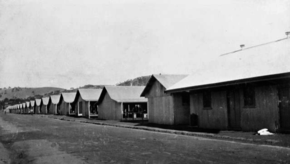
CUNNINGHAM, John Patrick
| Service Number: | 4273 |
|---|---|
| Enlisted: | 6 October 1916, Adelaide, South Australia |
| Last Rank: | Private |
| Last Unit: | 32nd Infantry Battalion |
| Born: | Bendigo, Victoria, Australia , 1888 |
| Home Town: | Norwood (SA), South Australia |
| Schooling: | Not yet discovered |
| Occupation: | Labourer |
| Died: | Killed in Action, France, 24 June 1918 |
| Cemetery: |
No known grave - "Known Unto God" Buried by Rev A.O'Sullivan 1/20.000 62D K.25 A.61, Villers-Bretonneux Memorial, Villers-Bretonneux, Picardie, France |
| Memorials: | Adelaide National War Memorial, Australian War Memorial Roll of Honour, Edithburgh Public School Roll of Honour, Edithburgh WW2 Roll of Honor, Norwood St Bartholomew's Anglican Church Honour Roll, Norwood War Memorial, Villers-Bretonneux Memorial |
World War 1 Service
| 6 Oct 1916: | Enlisted AIF WW1, Private, 4273, Adelaide, South Australia | |
|---|---|---|
| 7 Nov 1916: | Embarked AIF WW1, Private, 4273, 32nd Infantry Battalion, --- :embarkation_roll: roll_number: '17' embarkation_place: Adelaide embarkation_ship: HMAT Afric embarkation_ship_number: A19 public_note: '' | |
| 7 Jun 1917: | Involvement AIF WW1, Private, 4273, 32nd Infantry Battalion, Battle of Messines |
World War 2 Service
| 6 Mar 1918: | Wounded Contusion of hip and right hand (not in performance of military duty). Discharged 12 days later and granted balance of furlough and to proceed overseas to join Unit on the 29th. |
|---|
World War 1 Service
| 24 Jun 1918: | Involvement AIF WW1, Private, 4273, 32nd Infantry Battalion, "Peaceful Penetration - Low-Cost, High-Gain Tactics on the Western Front", Killed in Action |
|---|
Help us honour John Patrick Cunningham's service by contributing information, stories, and images so that they can be preserved for future generations.
Add my storyBiography contributed by St Ignatius' College
John Patrick Cunningham was born in Bendigo, Victoria, Australia and died on the 24thof June 1918. He followed the Roman Catholic religion and was unmarried with an occupation of a labourer before enlisting to fight for Australia during World War 1.[1]John’s appearance was quite different compared to his capabilities as he had a height of 5 feet and 1½ inches (1.56 metres), a weight of 127 lbs (57.61 kilograms) and a chest measurement of 33-34 inches (83.82 to 86.36 centimetres). He had blue eyes, brown hair and a fresh complexion. His sister; Mrs Mary Moyse lived at 3 Elizabeth Street, Norwood, South Australia.[2]
John Cunningham enlisted for the second time on the 6th of October 1916 at the age of 28 years and 7 months. He received four vaccines prior to his embarkation and underwent an examination which he passed on the 9thof October 1916. He had previously been rejected for being unfit to serve in the war because he was ‘too short.’ The Medical officer had commented that he was “a little below standard in height but particularly sturdy and fit.” Cunningham’s address was ‘Norwood, South Australia 32ndBattalion, 11th reinforcement’ and was assigned to the Army where he would fight as a private alongside many other Australian men. He served the Australian Imperial Force and embarked from Adelaide, South Australia, on board the HMAT A19 Afric on the 7th of November 1916.[3]John marched in from England at Etaples on the 7thof April 1917 and marched out to Unit the following day. He was taken on strength on the 12th, making his Will at Mitcham Military Camp; South Australia on the 24thof July. His Will was lodged with his next kin who was his sister and was witnessed by J. H. Jary and Corporal Gee E. A. Kelly.
On the 7thof March 1918, John was on service leave from France in the United Kingdom until admitted into King George Hospital, Stamford Street Waterloo SE1 9NHwith a bruised mouth. He spent a total of 12 days in hospital and was discharged on the 18th but re-admitted soon after due to a contusion of his hip and right hand which was not caused while in performance of military duty though he was not to blame. After being discharged from King George Hospital, John was granted a balance of furlough and to proceed overseas to join the Unit ex on the 29thof March that year. He re-joined the Unit ex Sick on the fighting field.
At the age of 30, John Patrick Cunningham was killed in action on the 24thof June 1918 while fighting on the fields of France. His death had been confirmed by the Commandant, A.I.F., Headquarters in London on the 8thof July 1918 by mail.[4] John’s sister Mrs Mary Moyse had received the news of her brother’s death and immediately wrote to Major Lean asking for the official confirmation of John’s death. She also informed him that she had planned to “request the Public Trustee to administrate.”[5]
John was buried by Reverend A.O’Sullivan. His name can be read on the Roll of honour on panel 120 in the Commemorative Area in the 120 Australian War Memorial.[6]He received the British War Medal, the Victory Medal and the Star Medal in memory of his service while fighting in World War 1 and to remember the sacrifices he made while fighting for Australia.[7]
[1]The AIF Project - John Patrick CUNNINGHAM 2016, UNSW Australia, Canberra, accessed 5 March 2018, <https://aif.adfa.edu.au/search>.
[2]Item details for: D2994, CUNNINGHAM J P 2017, accessed 2 March 2018, <https://recordsearch.naa.gov.au/SearchNRetrieve/Interface/DetailsReports/ItemDetail.aspx?Barcode=1988785&isAv=N>.
[3]Her Majesty's Australian Transports [HMAT] Ships n.d., accessed 6 March 2018, <http://alh-research.tripod.com/ships_lh.htm>.
[4]John Patrick Cunningham - Discovering Anzacs - Nation Archives of Australia 2018, Australian Government, Australia, accessed 4 March 2018, <https://discoveringanzacs.naa.gov.au/browse/person/139086>.
[5]Item details for: D2994, CUNNINGHAM J P 2017, accessed 2 March 2018, <https://recordsearch.naa.gov.au/SearchNRetrieve/Interface/DetailsReports/ItemDetail.aspx?Barcode=1988785&isAv=N>.
[6]FIRST WORLD WAR EMBARKATION ROLL John Patrick Cunningham 2017, accessed 3 March 2018, <https://www.awm.gov.au/collection/R1874752>.
[7]Item details for: D2994, CUNNINGHAM J P 2017, accessed 2 March 2018, <https://recordsearch.naa.gov.au/SearchNRetrieve/Interface/DetailsReports/ItemDetail.aspx?Barcode=1988785&isAv=N>.
[8]Anzac Day 2016, accessed 20 March 2018, <https://www.army.gov.au/our-history/traditions/anzac-day>.
[9]ANZAC Day | The Sprit of Anzac 2016, accessed 21 March 2018, <https://anzacday.org.au/spirit-of-anzac>.
























